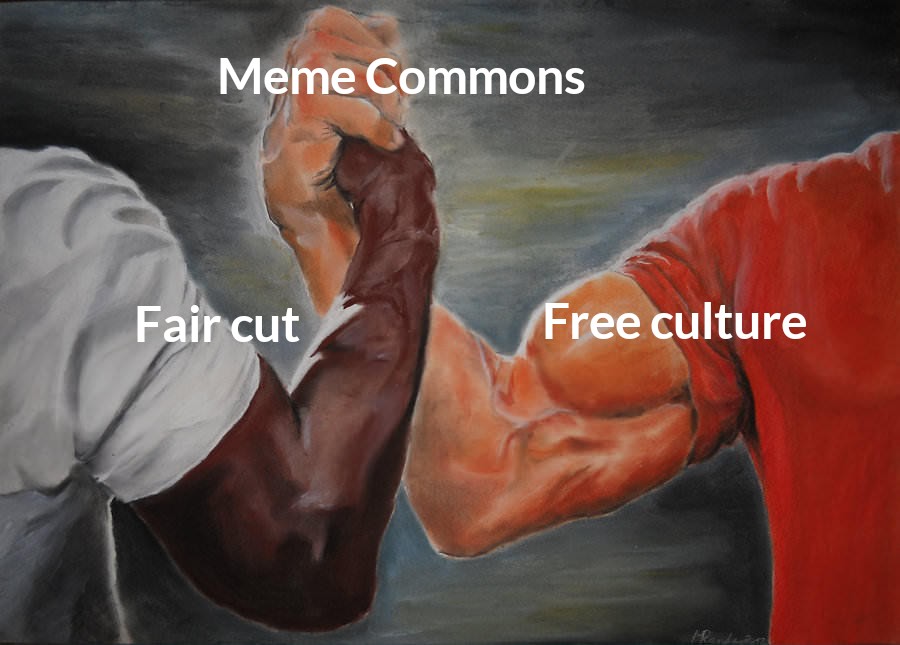Meme Commons
Sharing the Value of Culture
Creating a world where creativity and culture are unleashed through a natural sharing of value.

What is Meme Commons?
The Meme Commons movement is driven by two fundamental principles: free circulation of works and value sharing.
To allow cultural exploitation to adapt to internet behaviors and to the decentralization phenomena driven by Blockchain technologies, it is necessary to build a legal ecosystem based on a balance of the freedoms and interests at stake.
This is the essential reason for the Meme Commons License: to promote and protect the creations of the human mind according to certain principles of copyleft - freedom of use, copying, distribution, transformation -, with the counterpart of rewarding the authors and Intellectual Property right holders by a fair cut.
With the development of Blockchain technologies, crypto-assets, NFTs, and metaverses, any digital content is now valuable.
Through its license, the Meme Commons movement gives birth to the first chain of exploitation license: the CommonChain.
To allow cultural exploitation to adapt to internet behaviors and to the decentralization phenomena driven by Blockchain technologies, it is necessary to build a legal ecosystem based on a balance of the freedoms and interests at stake.
This is the essential reason for the Meme Commons License: to promote and protect the creations of the human mind according to certain principles of copyleft - freedom of use, copying, distribution, transformation -, with the counterpart of rewarding the authors and Intellectual Property right holders by a fair cut.
With the development of Blockchain technologies, crypto-assets, NFTs, and metaverses, any digital content is now valuable.
Through its license, the Meme Commons movement gives birth to the first chain of exploitation license: the CommonChain.
Why use the Meme Commons license?
Apart from certain exceptions, copyright is in principle, based on a privatist monopoly that requires the author's permission to use, copy, distribute or transform a piece of work.
Because of the behaviors on the Internet, this mechanism causes today an enormous loss of earnings for the authors, and a permanent insecurity for the Internet users.
The Meme Commons license opens the way to a new mode of exploitation based on a principle of reward that is part of a social contract. It transforms the privatist principle into an exception, and allows authors to generate value when anyone generates income from their work or a derivative work.
The Meme Commons license links each work in a CommonChain through a value-sharing mechanism, and thus:
- Encourages authors to give freedom to use, copy, distribute and transform their creations;
- Rewards authors for their creative efforts;
- Creates new economic models that stimulate the creation, circulation, exchange and transformation of intellectual productions;
- Creates greater incentives for authors and rights holders to adopt modes of exploitation based on these economic models, and not on a private monopoly restricting access to intellectual productions.
Because of the behaviors on the Internet, this mechanism causes today an enormous loss of earnings for the authors, and a permanent insecurity for the Internet users.
The Meme Commons license opens the way to a new mode of exploitation based on a principle of reward that is part of a social contract. It transforms the privatist principle into an exception, and allows authors to generate value when anyone generates income from their work or a derivative work.
The Meme Commons license links each work in a CommonChain through a value-sharing mechanism, and thus:
- Encourages authors to give freedom to use, copy, distribute and transform their creations;
- Rewards authors for their creative efforts;
- Creates new economic models that stimulate the creation, circulation, exchange and transformation of intellectual productions;
- Creates greater incentives for authors and rights holders to adopt modes of exploitation based on these economic models, and not on a private monopoly restricting access to intellectual productions.